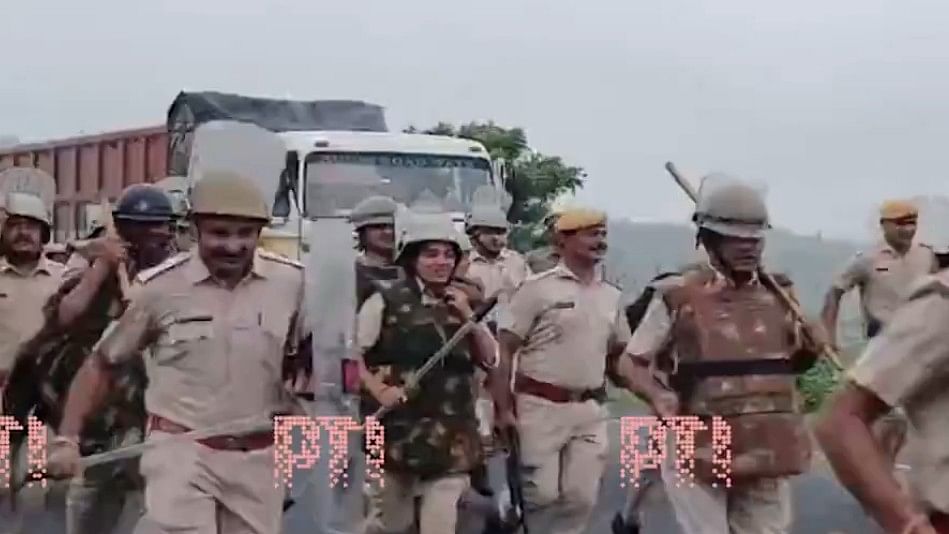
Scuffle broke out between locals and police in Chhoti Sarwan area of Banswara district of Rajasthan.
Credit: PTI Photo
Jaipur: Protestors, mainly tribals, clashed with the police on Friday in Rajasthan’s Banswara district over the proposed Mahi nuclear plant project, whose foundation stone is likely to be laid by Prime Minister Narendra Modi soon.
Violent clashes took place between locals, including women, for over three hours in the afternoon when the police went to take possession of the acquired land.
Protestors pelted stones while the police lathicharged women and used teargas to disperse the crowd. Three policemen and some villagers got injured in the ruckus. Police detained Bharat Adivasi Party leader, Hemant Rana and 11 other people. The police were able to get the land vacated.
According to Nuclear Power Corporation of India Limited (NPCIL), the site for the proposed project spreads over the villages of Adibheet, Bari, Red, Sajwana, Katumbi, Wank, Lalpura in Choti Sarwan tehsil and Khandiadev in Ambapura tehsil in Banswara district and is likely to displace over 3000 people.
The Mahi-Banswara Rajasthan Atomic Power Plant Project (MBRAPP) will produce 2800 MW power and falls under the category of ‘Nuclear Power Project and Processing of Nuclear Fuel.’ The total land required for the project (plant and township) is 660.15 ha. At least 553 ha of land has already been acquired.
NPCIL officials say a plan is being readied for the foundation stone laying ceremony by Prime Minister Modi either in August end or September first week.
People who have been affected due to land acquisition have been given at least 60 ha land near Khadiadev where they can shift. The government claims at least Rs 415 crore have been given as compensation.
In the morning when NCPIL officials came to oversee the building of the boundary wall of the plant, local people started gathering and shouted slogans against the plant. When the police tried to disperse the crowd, they started pelting stones and one of the policemen got a head injury, who had to be admitted to the hospital.
Protesting women descended on the national highway 927-A (Banswara-Dungarpur-Ratlam) highway and jammed the highway. When the police tried to scatter the crowd, they ran up the nearby hilly area and started pelting stones. Banswara Collector Dr Indrajit Yadav said some anti-social elements tried to create nuisance and police had to use mild force to disperse them.
Protesters are demanding that all local youths from the affected areas be given employment in the power plant and that each member in a family be considered as a separate entity and be given jobs and housing units.
Rajkumar Roat, the first time MP from Banswara, however, told Deccan Herald that it is just not jobs that these tribals are demanding. “There are two sets of protesting lines now , one where people are now aware of the environmental effects of nuclear power in their area and another set of people who are demanding jobs for local people. Here people are simple and readily agreed to get rehabilitated because they are not aware of environmental pollution and problems that can be a fallout of a nuclear power plant. Many of them now do not want a nuclear plant in their area. They want a safe, green environment instead. Many others want jobs. Our party is monitoring the issue and would discuss with all villagers and protestors and request the government to look into their demands.”
The issue found resonance in Vidhan Sabha today as BAP MLA Jaikishan Patel raised the issue.
On 18th July, displaced villagers had held a meeting where they had passed a resolution demanding scrapping of the nuclear power plant.
NPCIL project report claims that MBRAPP is being envisaged on the state art reactor technology. And a number of environment friendly and safety features have been envisaged to ensure the anticipated adverse environmental impact be avoided or minimised.
The aim is also to design the facility with a multilayer safety system in such a way that even if an event were to occur, the resulting unplanned releases are contained as far as practical. And provisions are being made for directing the releases along planned flow paths, thereby permitting their collection and treatment before discharge to the environment.